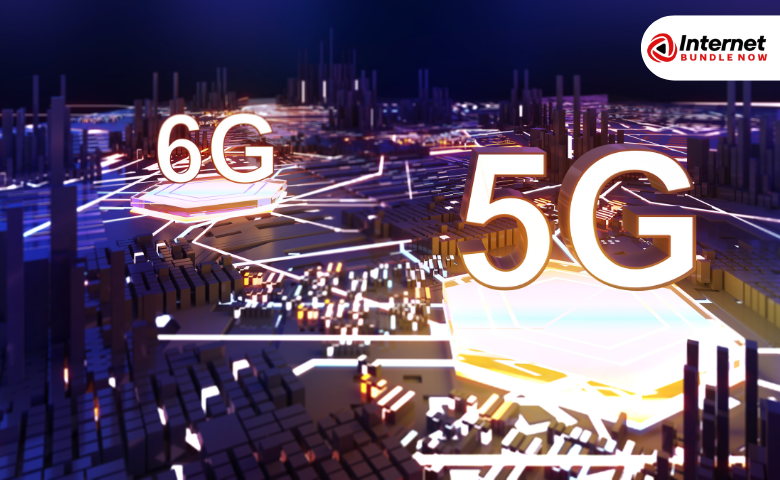- TV
How to Get Premium Channels with Your Cable TV Bundle?
Access to exclusive entertainment content is a priority for many viewers seeking a richer television experience. Premium chan...
Explore More
As the demand for faster, more reliable internet continues to skyrocket, the infrastructure supporting it must evolve. At Internet Bundle Now, we are at the forefront of this transformation, driving innovation in ISP infrastructure while preparing for the next generation of wireless networks—5G and 6G. Let's delve into how we and the industry are reshaping connectivity in the United States.
Network Backbone and Fiber Optic Networks: The backbone of our operations is a robust network of fibre optic cables that span the nation. These high-capacity lines are essential for handling the vast amounts of data our users generate daily.
Data Centers: Strategically located data centres nationwide ensure data is processed and delivered with minimal latency. These centres are the nerve centres of our operation, enabling seamless connectivity for millions of users.
Wireless Infrastructure: Our advanced wireless networks, which currently support 4G LTE and fixed wireless access, provide an essential alternative to traditional wired connections, particularly in underserved areas.
Despite these advancements, ISPs face ongoing challenges, including the need for continuous upgrades, maintaining security, and expanding access to rural and remote areas.
Broadband Technologies: We utilize a combination of DSL, cable broadband, and cutting-edge fibre optic broadband to meet the diverse needs of our customer base. Our fibre optic network, in particular, offers unmatched speed and reliability.
Wireless Internet Technologies: Our 4G LTE network is critical to our service offerings, delivering fast and reliable internet plans across the USA. We also deploy Fixed Wireless Access (FWA) solutions to reach customers in areas where wired connections are impractical.
Emerging Technologies: We closely monitor developments in satellite internet, hybrid fibre-coaxial (HFC) systems, and the latest DOCSIS 3.1/4.0 standards to ensure we remain at the cutting edge of ISP technology.
FCC Regulations and Policies: We adhere to all Federal Communications Commission (FCC) regulations, including those governing net neutrality, broadband accessibility, and spectrum allocation.
Impact of Government Policies: Policies related to spectrum availability and broadband expansion directly affect our ability to innovate and expand our services. We actively participate in discussions and initiatives that shape the industry's Future.
Security and Privacy Concerns: Protecting our customers' data is a top priority. We employ state-of-the-art security measures and comply with all privacy regulations to safeguard sensitive information.
Universal Service Fund (USF) and Rural Broadband Expansion: As part of our commitment to bridging the digital divide, we support the USF and other initiatives to expand broadband access to rural and underserved communities.
The advent of 5G technology marks a significant leap forward in wireless connectivity, and Internet Bundle Now is leading the charge in its deployment.
Introduction to 5G Technology: 5G offers unprecedented speed, low latency, and the ability to connect many devices simultaneously. This technology is set to revolutionize industries and everyday life.
Deployment Status in the USA: We are aggressively expanding our 5G network, with significant rollouts underway in urban centres and plans to extend coverage to rural areas. Our 5G network operates across low, mid, and high spectrum bands, ensuring comprehensive coverage and optimal performance.
Challenges and Barriers: Deploying 5G infrastructure includes significant investment costs, spectrum availability, and addressing public concerns about health and environmental impacts.
Use Cases of 5G: The potential applications of 5G are vast, from enhanced mobile broadband (eMBB) to ultra-reliable low-latency communications (URLLC) and massive machine-type communications (MTC). These innovations will drive advancements in healthcare, transportation, smart cities, and more.
Overview of 6G Technology: 6G is expected to deliver speeds up to 100 times faster than 5G, with ultra-low latency and the ability to support advanced technologies like quantum networking and terahertz communications.
Current Research and Development Efforts: We are investing in research partnerships with leading universities and tech companies to explore the potential of 6G. AI, machine learning, and edge computing are expected to play significant roles in developing 6G.
Potential Use Cases for 6G: The possibilities are limitless. 6G will enable fully immersive augmented reality (AR) and virtual reality (VR), autonomous vehicles, advanced intelligent cities, and an expansion of the Internet of Things (IoT) on a scale never seen before.
Challenges in 6G Development: Developing 6G will require overcoming significant technical challenges, navigating complex regulatory environments, and fostering global collaboration to ensure that this technology benefits everyone.
Economic Benefits of 5G/6G Deployment: The rollout of these networks is expected to create millions of jobs, drive GDP growth, and foster innovation across various sectors. Startups and tech companies will particularly benefit from the new opportunities these technologies create.
Impact on Various Industries: 5G and 6G will transform industries such as healthcare, manufacturing, transportation, and entertainment. For example, remote surgeries, intelligent factories, autonomous vehicles, and immersive entertainment experiences will all become a reality.Cost of 5G/6G Infrastructure Development: Building the necessary infrastructure for 5G and 6G is a massive undertaking. It requires substantial investment from the private sector, public-private partnerships, and government funding.
Advances in Network Virtualization and SDN: We are implementing Software-Defined Networking (SDN) and Network Function Virtualization (NFV) to create more flexible, scalable, and efficient networks.
Integration of AI and Automation in ISP Networks: Artificial intelligence and automation transform how we manage our networks, enabling predictive maintenance, real-time optimization, and enhanced customer experiences.
Potential for Convergence of Telecom and IT: The lines between telecommunications and information technology are blurring, leading to new service integration and innovation opportunities.
Emergence of Quantum Networking: While still in its infancy, quantum networking can revolutionize secure communications and data processing.
The next decade will bring unprecedented changes in how we connect, communicate, and interact with the world. We are excited to participate in this journey at Internet Bundle Now, driving the Future of connectivity.
Latest insights, tips, and updates from our experts.
George
ISP Infrastructure and The Future Of 5G/6G Networks in USA